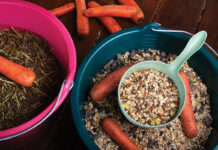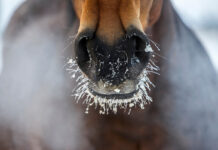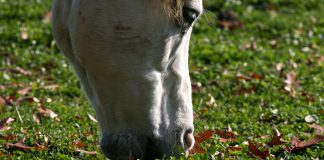
Horse owners across the country feed hay in various forms, including round bales, which are typically between 450 and 1,700 pounds; large square bales, which are typically 3x3x8 and weight 600 to 700 pounds; and small square bales, which are usually 2x2x4 and weight between 40 and 100 pounds.
Small square bales are usually made up of higher-quality hay. They are fed on a lot of boarding facilities and hobby farms. Rectangular in shape and held together by baling twine or wire, storing this hay can be labor intensive, but is usually the easiest way to feed smaller herds or show animals.
Tips for Stacking Square Bales
- Never stack baled hay directly on the ground; it can wick moisture, causing mold and ruining the bottom bales. Place pallets or even a layer of straw on the ground before beginning to stack hay.

- If using pallets, consider placing plywood or tarps over them to prevent hay from falling in between the pallet and the ground. This space, filled with hay, can be comfy and inviting for mice and rats in the wintertime.
- Stack the bottom layer of hay bales on their sides, with cut end facing up. This allows for better air circulation.
- Stack the second layer of hay with their strings facing up, perpendicular to the first layer.
- Alter the direction in which you stack the rest of the hay to prevent leaning.
- If one bale you’re handling feels heavier than the others, it may contain more moisture. Leave it cut-side up, out of the stack and ideally outside the building in dry conditions to let it cure. Square bales should have a moisture content of below 20 percent; more than that can lead to heat build-up and the risk of combustion.
- Make sure to stack bales as tightly as possible next to one another to prevent an unstable stack. You’ll have to use some muscle to wedge them tightly together.

- Keep bales that are shorter or longer than average out of the stack to avoid inconsistency. You can place them at the apex of the pile to be fed first.
- Additionally, save loose bales for either the top of your stack or to feed right away; stacking them with tighter bales will reduce your hay stack’s strength.
- Make sure the stack height doesn’t exceed the shortest base dimension more than 1.5 times (for example, if the stack is 20 feet wide and 40 feet long, don’t stack hay higher than 30 feet).
- Always complete the entire first row before moving on to the second row and make sure the corners are square; this will help with stack stability.
- Sprinkling a bit of rock salt in between each layer of hay is helpful in preventing moisture build-up and moldy hay.
Keeping your haystack stable and mold- and pest-free requires a bit of diligence, but knowing your horses are well fed no matter the weather makes it worth it.
Liked this article? Here’s more on hay:
All About Hay
Hay Buying without the Hassle
Have a Healthy Barn







OK, all you Horse Channel readers, come to my place so you can all practice all the ideas about how to stack small square hay bales. You can practice on the loads that will be arriving soon. I will even make cookies….hee, hee!!
HAHAHAHAHA! ok, i think we’ll just show up for cookie time!!! i’ll bring sweet tea! LOL!
I’ve always wondered how to properly stack hay and it seems everyone has their own way and opinion. Thank you for this article.
But, I just want to ask for some clarification. The article says to start the stack with the cut end up (so strings are facing to the side, correct?). Then it says to lay the second row with strings facing up (on it’s side). And you alternate the rows, say first row the bales are long-ways east and west, then second row bales are long-ways north and south, then third row east to west again, etc., etc.) Am I correct so far?
So now for the clarification I’d like… The pics in the article, the first one is hard to tell, but the second shows the bales stacked with the strings facing to the side on all the rows.
Is this the correct way or is it the way I described earlier?
Thanks so much for the info.
Sincerely,
Cindy Kirk
Interesting.
informative
Practice time at my farm this evening!!! Bring gloves and muscles!!